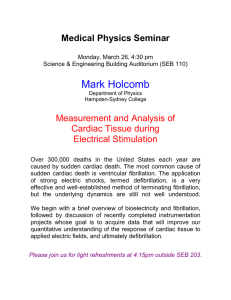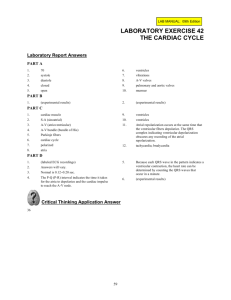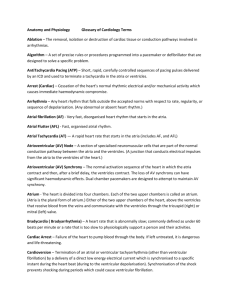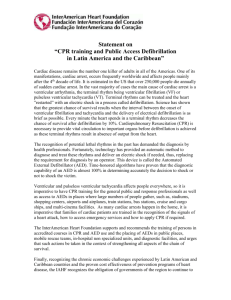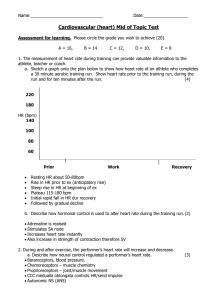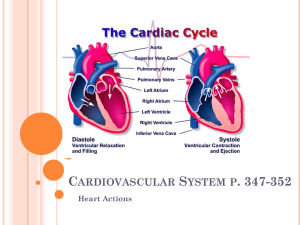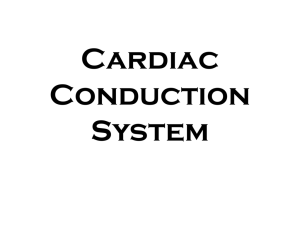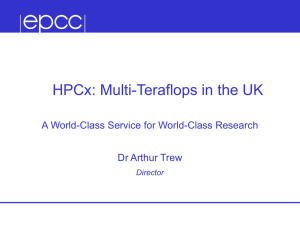Integrative Biology: Real science through e-Science
advertisement
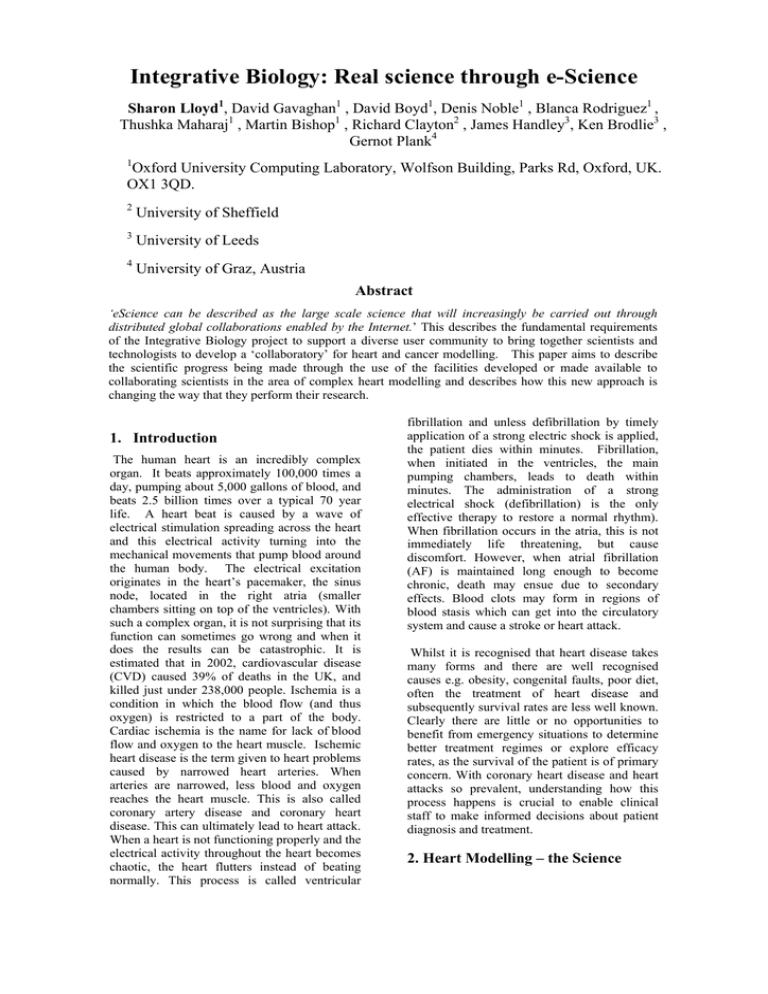
Integrative Biology: Real science through e-Science Sharon Lloyd1, David Gavaghan1 , David Boyd1, Denis Noble1 , Blanca Rodriguez1 , Thushka Maharaj1 , Martin Bishop1 , Richard Clayton2 , James Handley3, Ken Brodlie3 , Gernot Plank4 1 Oxford University Computing Laboratory, Wolfson Building, Parks Rd, Oxford, UK. OX1 3QD. 2 University of Sheffield 3 University of Leeds 4 University of Graz, Austria Abstract ‘eScience can be described as the large scale science that will increasingly be carried out through distributed global collaborations enabled by the Internet.’ This describes the fundamental requirements of the Integrative Biology project to support a diverse user community to bring together scientists and technologists to develop a ‘collaboratory’ for heart and cancer modelling. This paper aims to describe the scientific progress being made through the use of the facilities developed or made available to collaborating scientists in the area of complex heart modelling and describes how this new approach is changing the way that they perform their research. 1. Introduction The human heart is an incredibly complex organ. It beats approximately 100,000 times a day, pumping about 5,000 gallons of blood, and beats 2.5 billion times over a typical 70 year life. A heart beat is caused by a wave of electrical stimulation spreading across the heart and this electrical activity turning into the mechanical movements that pump blood around the human body. The electrical excitation originates in the heart’s pacemaker, the sinus node, located in the right atria (smaller chambers sitting on top of the ventricles). With such a complex organ, it is not surprising that its function can sometimes go wrong and when it does the results can be catastrophic. It is estimated that in 2002, cardiovascular disease (CVD) caused 39% of deaths in the UK, and killed just under 238,000 people. Ischemia is a condition in which the blood flow (and thus oxygen) is restricted to a part of the body. Cardiac ischemia is the name for lack of blood flow and oxygen to the heart muscle. Ischemic heart disease is the term given to heart problems caused by narrowed heart arteries. When arteries are narrowed, less blood and oxygen reaches the heart muscle. This is also called coronary artery disease and coronary heart disease. This can ultimately lead to heart attack. When a heart is not functioning properly and the electrical activity throughout the heart becomes chaotic, the heart flutters instead of beating normally. This process is called ventricular fibrillation and unless defibrillation by timely application of a strong electric shock is applied, the patient dies within minutes. Fibrillation, when initiated in the ventricles, the main pumping chambers, leads to death within minutes. The administration of a strong electrical shock (defibrillation) is the only effective therapy to restore a normal rhythm). When fibrillation occurs in the atria, this is not immediately life threatening, but cause discomfort. However, when atrial fibrillation (AF) is maintained long enough to become chronic, death may ensue due to secondary effects. Blood clots may form in regions of blood stasis which can get into the circulatory system and cause a stroke or heart attack. Whilst it is recognised that heart disease takes many forms and there are well recognised causes e.g. obesity, congenital faults, poor diet, often the treatment of heart disease and subsequently survival rates are less well known. Clearly there are little or no opportunities to benefit from emergency situations to determine better treatment regimes or explore efficacy rates, as the survival of the patient is of primary concern. With coronary heart disease and heart attacks so prevalent, understanding how this process happens is crucial to enable clinical staff to make informed decisions about patient diagnosis and treatment. 2. Heart Modelling – the Science What is evident from clinical observations is that whilst we can determine some information from activity on the surface of the heart and from observations of how it is pumping our blood, it is difficult to know what is actually happening within the vessels and the tissues and with experimental work on heart function limited, there has long been recognized the need to use alternative methods to determine how the heart works, how it behaves in arrhythmogenesis as well as how to treat these diseases. Realistic computational models of the heart, sometimes referred to as “virtual heart simulators”, are currently the only viable approach to allowing us to observe all parameters of interest at sufficient spatial and temporal resolution. This section aims to highlight a selection of the heart modeling research which is being undertaken in conjunction with Integrative Biology. Forty years of research have yielded extensive experience of modelling the cellular activity [1], [2] commencing with the work of Professor Denis Noble in Oxford in 1960. Since then, researchers have been simulating how cells behave and how electrical activity in the heart can be determined using these cell models. Oxford and Auckland have worked on joint research activity to explore cardiac activity through cell and tissue models and the recently funded Wellcome Trust Heart Physiome project shows their commitment to this field. This project aims to build on existing models to help understand different mechanisms of arrythmias. A simple change in a computer model or input parameter can replicate a mutation in a channel protein, for example, and the impact of that change can be followed in the model of the whole organ. This approach is already showing promising results and providing an insight into why arrythmias that look very similar when recorded on an electrocardiogram (ECG) can have many possible underlying causes. If we take the models used by Denis Noble, which form the basis for many areas of research into heart disease and its treatment, we see that his models focused on the discovery and modelling of potassium channels in heart cells and the electric current flow through a cell wall [3] . Models of calcium balance were made in the 1980s and these have progressed extensively since then to a high degree of physiological detail. During the 1990s, these cell models were utilised to model anatomically detailed tissue and organ anatomy. Supplementing this is an understanding of how the tissues in the heart shear and move with every heart beat and how blood flows through the heart when it is pumping as well as an understanding proton transport mechanisms as modelled by Professor Richard Vaughan-Jones, as protons affect the metabolic function of heart cells. Molecular modelling by Professor Mark Sansom supports the work on proton transport. Treatment of ischemia and fibrillation is an area of interest in heart modelling as resuscitation techniques in hospitals require informed refinement to improve patient survival rates. It has been found through in-silico studies in Oxford and Tulane that ventricular anatomy and transmural heterogeneities determine the mechanisms of cardiac vulnerability to electric shocks and therefore of defibrillation failure. This knowledge is important for the design of new protocols for defibrillation, which could consist for example in the application of smallmagnitude shocks to particular locations in the ventricles. This could result in a dramatic decrease in the defibrillation threshold (which could be defined as the minimum shock strength required to terminate the arrhythmogenic activity in the ventricles in order to restore sinus rhythm or "to reset the ventricles"). Collaboration between the Medical University of Graz in Austria and University of Calgary has resulted in the development of a cardiac modelling package called CARP (Cardiac Arrhythmia Research Package, http://carp.meduni-graz.at). CARP is a multipurpose cardiac bidomain simulator which has been successfully applied to study the induction of arrhythmias , the termination of arryhthmias by electrical shocks (defibrillation) and also for the development of novel micromapping techniques. CARP is optimized to perform well in both shared memory and distributed memory environments. Besides pure computing capabilities, CARP comprises also visualization tools (Meshalyzer) and mesh generation tools. In Sheffield, computer models have been developed to model the process of ventricular fibrillation and resulting sudden cardiac death, as well as electric wave re-entry and fibrillation when the heart becomes unstable. Complex visualisation techniques have been developed to aid in this process and allow the tracking of filaments (centre of a spiral wave) in 2D and 3D where re-entrant activity manifests itself in the form of spirals (2D) and waves (3D). Optical mapping is a widely used experimental technique providing high-resolution measurements of cardiac electrical activation patterns on the epicardial surface through the use of voltage-sensitive fluorescent dyes. However, inherent to the mapping technique are blurring and distortion effects due to fluorescent photon scattering from the tissue depths. Researchers in Oxford, in collaboration with US partners have developed a mathematical model of the fluorescent signal that allows simulation of electrical recordings obtained from optical mapping experiments A bi-domain representation of electrical activity is combined with finite element solutions to the photon diffusion equation to simulate photon transport within cardiac tissue during both the excitation and emission processes. Importantly, these simulations are performed over anatomicallybased finite element models of the rabbit ventricles, allowing for direct comparison between simulation and whole-heart experimental studies [4]. These various approaches show how individual research is progressing in different areas and how, through collaboration with partner sites, the skills of other scientists are being leveraged. 3. Heart Modelling – the computing challenge Modelling the human heart in its entirety is beyond the capabilities of even the largest supercomputer. Even the smallest modelling activity has historically proved to be a challenge for a typical modeller who has developed and refined their models on their local desktop of laptop. Models would typically run for many days if not weeks, limiting the capacity of simulations achievable with existing infrastructures. Some laboratories have been lucky enough to have local clusters usable by scientists and if these scientists were lucky enough to have the support of those managing these infrastructures, they could benefit from the use of local services. Management of their data has, however, been ad hoc and often scientists lacked the facilities to manage data correctly with suitable metadata and provenance capture capability. Preliminary statistics showed that to run 2ms of electrophysiological excitation of a slab of tissue from the left ventricular wall, using the Noble 98 heart model would require 1 day to compute on HPCx. This was calculated using a mesh with 20,886 bilinear elements (spatial resolution 0.6mm) and over 40 timesteps of 0.05ms timestep. Clearly this is a huge scientific task which will require the collaboration of many researchers, but the infrastructure needs will also be extensive, with the need for seamless and secure data repositories to manage both the input data and the generated results, for fast compute facilities with potentially high speed networks enabling fast communication between the facilities, and extensive visualisation tools, generating geometry details remotely, enabling the scientists to visualise the results real time. By working with scientists in the design of such an infrastructure and in the development of overarching virtual research environments to support this research process, Integrative Biology aims to develop an infrastructure which enables this science to achieve the anticipated results in finding the key to preventing and treating disease. The computing services we are developing within the project allow researchers to target simulations at the most appropriate computer system depending on the resources and response needed. They provide data and metadata management facilities, using the Storage Resource Broker (from UCSD), for looking after the many datasets created in computational experiments, and visualisation tools for examining results and discussing these collaboratively within the consortium. An associated project, funded by the Joint Information Systems Committee, is developing a Virtual Research Environment that is embedding these services into a portal-based framework so they are easily usable by researchers who are not themselves computing experts. Present capability allows users to submit their models to NGS and HPCx through a portal interface or Matlab interface and manage their data and provenance information through the concept of an experiment. This has opened up a new way of working for our scientific collaborators and the following section shows some of the results of this grid enabled science. 4. Examples of improved science through e-science The following sections will describe the results of Integrative Biology users who have leveraged the technical capability offered to them to perform their science in new ways. These in- silico experiments have resulted in publications in renowned journals and conferences (not only heart modelling, but also electrophysiology and computer science). 4.1 Heart de-fibrillation on NGS Dr Blanca Rodriguez and her collaborators in Oxford and Tulane have worked on how to apply electric shocks to the heart to restart it and investigating the affect of disease of the heart on its effectiveness. Their research has explored ‘windows of vulnerability’ regarding the timing of its application of the shocks when the efficacy is reduced. To do so, they have used a code called Memfem from Tulane from the US, which uses a finite element solver and 2 PDEs (partial differential equations) coupled with a system of ODEs (ordinary differential equation). Each small project has about 150 jobs and each job generates 250 output files (each 4Mb), which amounts to 150Gb per project. Figure 1. Finite element mesh of the Tulane model (141 828 nodes) with realistic fibre architecture The ventricles are paced at the apex and after 7 beats, shocks of several shock strengths are applied to the computer model at different timings. Researchers vary the length of time between the last paced beat and the time of shock application (i.e. coupling interval), as well as shock strength to obtain the area of vulnerability, which is a 2D grid that encompass the combinations of coupling interval and shock strength that lead to shock-induced arrhythmogenesis. Many of the runs are independent so can be run simultaneously. Having access to NGS and SRB has been a vital resource in conducting this research. Already Dr Rodriguez and her team have made some surprise findings. “During the first 10-15 minutes after a heart attack, the shock strength necessary to defibrillate the ischemic heart is similar as in a healthy heart. This is surprising, as there are lots of changes going on in the oxygen deprived tissue over that time” [5,6]. These results have been obtained for a particular size of oxygen-deprived region with a rabbit heart model only and that they may not apply to larger regions or to the human heart. But they’re sufficiently intriguing to warrant further investigation. It is hoped that subsequent experiments will be able to quantify the time limit for re-starting a heart and thus improve patient treatment. 4.2 Transmural electrophysiological heterogeneities: Experimental and theoretical studies in both isolated ventricular tissue [7], and single myocytes [8] have proved that transmural dispersion in action potential duration (APD) exists, which results from changes in ionic properties in the depth of the ventricular wall. In particular, three layers of functionally-different cell types have been identified, namely the epicardial, endocardial and midmyocardial layers. Experimental and theoretical studies have proved that transmural dispersion in APD in the ventricles, which varies with age [9] and animal species [9] may modulate the arrhythmogenic substrate and thus could alter defibrillation efficacy. However, the role of transmural heterogeneities in the mechanisms underlying defibrillation failure is unknown. Thushka Maharaj and her collaborators used the sophisticated computer model of stimulation/defibrillation developed at Tulane University, to provide mechanistic insight into the role of transmural electrophysiological heterogeneities in cardiac vulnerability to electric shocks [10]. The insight provided by the simulations revealed that increased transmural dispersion in action potential duration within the left ventricular free wall resulted in an increase in the likelihood of arrhythmia induction in the heart. Thus, the inclusion of electrical heterogeneities resulted in an increase in cardiac vulnerability to electric shocks. These simulations, requiring extensive computing power, were ran on the UK NGS and data were stored in the NGS SRB. 4.3 Understanding Ventricular Fibrillation Current research at Sheffield University supported by the Integrative Biology project is focusing on understanding the mechanisms that initiate and sustain ventricular fibrillation (VF). Computer-intensive simulations using whole ventricle detailed anatomy and biophysically detailed models of electrical excitability are run on HPCx, and these build on simulations using simplified models that are run on local HPC resources including the White Rose Grid. A key aspect of this work is to relate the findings to clinical practice. Work on modelling the initiation of VF has already yielded information that could be used to identify patients at risk, and this is the basis of a pilot clinical study about to start in collaboration with clinical colleagues at the Northern General Hospital in Sheffield. Work on the mechanisms that sustain VF is also tightly meshed with clinical and experimental studies, and is one component of a wider project focusing on understanding VF in the human heart that also involves the Universities of Auckland, Utrecht, Oxford, and UCL. The current version of SCAM (the Sheffield Cardiac Arrhythmia Model) is written in C, uses shared memory parallelism, and runs on a single frame of HPCx. The code has been optimised for the HPCx architecture, and ongoing development aims to further exploit the mixed mode parallelism capability of HPCx, so that simulations can be run across large numbers of frames. Results of simulations using SCAM show initiation and development of fibrillation in the ventricles (Figures 2 and 3). Paced Premature Figure 2. Simulation showing the initiation of fibrillation in the ventricles The top panel shows simulated electrocardiogram (ECG). Red arrows indicate three stimuli to the apex (bottom) of the heart that result in normal placed beats at intervals of 300ms, and green arrow indicates premature stimulus delivered to the heart wall. The premature stimulus results in the onset of fibrillation, shown by rapid and self-sustained activity in the simulated ECG. Bottom panel shows snapshots of the simulation, where electrical activation is colour coded with blue indicating resting tissue and red indicating active tissue. The first frame (650 ms) shows the propagation of the third paced beat shortly after the stimulus has been applied to the apex (bottom) of the heart. The second frame (790 ms) shows the state of the heart just before the premature stimulus is applied over the region shown. Part of this region has yet to recover, shown by the yellow and light blue regions. The third frame shows the effect of the premature stimulus. The activity resulting from the stimulus can only propagate outwards and downwards because it cannot propagate into areas that are still recovering. Figure 3. Simulation showing the development of fibrillation in the ventricles Top panel shows isosurface views, where electrically active regions are enclosed by yellow surfaces. The first frame (820 ms) shows how the downward propagating activity shown in Figure 2 is beginning to curl around as the tissue recovers from the paced beat, and forms a pair of counter-rotating scroll waves. In the second frame (870 ms) these scroll waves have rotated by about 180 degrees, but the activation pattern is unstable, and by the third frame (1200 ms) the initial scroll wave pair has broken up into multiple interacting waves. Bottom panel shows scroll wave filaments – the lines around which the scroll waves rotate. In the first two frames there are two filaments, one for each of the scroll waves. In the third panel (1000 ms) there are 8 filaments, reflecting the more complex activation pattern resulting from the initial instability. 4.4 Cardiac Simulation on HPCx In a preliminary study at the Medical University of Graz using the Integrative Biology framework, the feasibility of carrying out a “virtual experiment” was tested using HPCx. A computer model of a ventricle, discretized at an average spatial resolution of 200 µm, was simulated immersed in a conductive bath. At the bath boundaries, two plate electrodes were placed next to the anterior and posterior faces of the ventricle (Figure 4A).To test conditions under which an arrhythmia can be induced, a train of 10 pacing pulses of varying basic cycle length was delivered (Figure 4B). After the last pacing pulse, 2 seconds of activity were simulated to examine whether an induced arrhythmia was sustained or self-terminated (Figure 4C). Performing this virtual experiment involved the solution of an elliptic PDE (862,515 unknowns), a parabolic PDE (547,680 unknowns) and a set of 21 non-linear ODE’s, defined at the same grid as the parabolic PDE. Using a temporal discretization step of 8µs, the solution scheme had to be repeated 500,000 times to complete the experiment. Preliminary simulations carried out on a Dual Opteron desktop computer suggested that execution times would be around 2 months. Using 128 CPUs of HPCx allowed the execution of a single experiment in only 10 hours. The simulations were carried out using the CARP simulator. A subset of this simulation was repeated using different numbers of CPUs to demonstrate the scalability of the method (Figure 5). The overall computational workload is clearly dominated by the elliptic problem (> 95% of the overall workload). The parabolic PDE, solved by a simple forward Euler integration step, showed super-linear scaling. As expected, the ODE solver scaled linearly since the involved variables do not diffuse and thus no communication is required. The dominating elliptic problem scaled well, although the parallel efficiency decreased slightly when going from 64 to128 CPUs. Taking into account that this problem size is rather small for the high number of CPUs the scaling efficiency is more than satisfying. These preliminary results suggest that realistic simulations of a human heart including a torso are feasible on the HPCx platform. In such simulations one has to deal with roughly 20-200 million unknowns (20-200 times larger than in this study). Memory usage and execution times will require the use of more CPUs. It is expected that parallel efficiency will increase significantly thanks to a more favourable ratio between local computational load and communication. Figure 4. A virtual experiment. Figure 4 shows results from a setup for a “virtual experiment” to induce an arrhythmia in the ventricles by applying an electrical pacing protocol: A) The ventricles are immersed in a conductive fluid and place between two plate electrodes. B) Electrical activation of the ventricles during the stimulation period. C) After the last pacing pulse, a so-called figure-ofeight re-entry (named after the movement of the tips of the wavefronts) ensued and was sustained until the end of the simulation run at 4000 ms Figure 5. Benchmark results: scaling of different portions of the bi-domain computation In figure 5, as expected, the ODE part scaled linearly (no communication required).The parabolic problem, solved by a simple forward Euler step, basically involved only a matrixvector product which showed super-linear scaling. Computations were dominated by the elliptic problem which scaled reasonably well, particularly if one takes into account that the problem size is small for the number of CPU’s employed in these simulations. Overall execution time in hours is shown as a function of the number of CPU’s. 4.5 Modulation of Shock-End Virtual Electrode Polarisation as a Direct Result of 3D Fluorescent Photon Scattering The following project has been conducted by Martin Bishop in Oxford using complex mathematical models from Tulane and results from experiments conducted by Igor Efimov’s laboratory in St. Louis. For the first time, a model of photon scattering has been used to accurately synthesize fluorescent signals over the irregular geometry of the rabbit ventricles following the application of strong defibrillation shocks. During such stimulation protocols there is a large transmural variation in transmembrane potential through the myocardial wall. It is thus thought that fluorescent photon scattering from depth plays a significant role in optical signal modulation at shock-end. A bidomain representation of electrical activity is combined with finite element solutions to the photon diffusion equation, simulating both the excitation and emission processes, over an anatomically-based model of ventricular geometry and fiber orientation. Photon scattering from within a 3D volume beneath the epicardial optical recording site is shown to transduce these differences in transmembrane potential within this volume through the myocardial wall. This leads directly to a significantly modulated optical signal response with respect to that predicted by the bidomain simulations, distorting epicardial virtual electrode polarization produced at shockend. We can also show that this degree of distortion is very sensitive to the optical properties of the tissue, an important variable to consider during experimental mapping set-ups. These findings provide an essential first-step in aiding the interpretation of experimental optical mapping recordings following strong defibrillation shocks. (A) (B) Figure 6 Surface distribution of transmembrane potential (A) and synthesized optical signal (B) 50ms following apical stimulation. 5. Supporting Technology Enabling this science is an architecture that abstracts away the complexity of working with disparate compute and data resources. This architecture has leveraged work from early eScience projects. In order to handle the diversity of end-users – or to be more precise, the diversity of environments in which our endusers routinely work – and the diversity of IT systems which they wish to exploit, the infrastructure is organized into 4 major layers. The upper layer is provided in two formats, one portal based to minimize the footprint on the users desktop/laptop, and the other based on a variety of familiar desktop tools such as Matlab to provide modellers with access to IB services in an environment in which they have already invested a significant learning and development effort. For some services, such as advanced visualization specific to these types of applications, some client-side support is required, necessitating the downloading of specific clients. This layer will also provide the interaction services for collaborative visualization which are required for steering and in situ decision making by partners. The next layer contains Integrative Biology (IB) Services. These provide a defined, extensible set of services offering a simple abstract interface to the range of IT systems and facilities required by IB cardiac and tumour modellers. Supporting the IB Services are a set of Basic Services targeted at the various IT systems available to IB. These include frontends to the Storage Resource Broker (SRB) data management service running on the UK National Grid Service (NGS) and low level job submission facilities provided by the Globus Toolkit 2 (GT2) and the Open Middleware Infrastructure Institute (OMII) , plus access to resources such as visualization and steering developed by the project. This Basic Services layer and the higher IB Services layer are Web service based. The Basic Services provide access to the underlying IT infrastructure systems used by the project through a variety of access mechanisms. Management of the data created within a distributed research community is a major challenge for the IB project. Important factors are the provision of a secure infrastructure in which users can store their valuable and potentially sensitive data with the ability to control who has access to that information; the ability to share data selectively through the concept of a collaborative experiment with the principal investigator in the experiment controlling access rights; and leveraging mature facilities for data management already developed by one of the project partners, CCLRC. The total volume of project data held in SRB is approaching 0.5TB, the majority of which is raw output from numerical simulations. IB files are organized by studies and experiments and managed through use of a metadata schema based on the CCLRC Schema for Scientific Metadata. 6. Conclusions Researchers across the Integrative Biology consortium are developing complex computer models to look at aspects of how the heart operates and by coupling these models, these researchers hope to be able to determine what causes heart disease and potentially how to prevent heart disease. These complex models require immense amounts of compute power which is not available on the scientists desktop. For this reason, the project is enabling access to HPC resources through the National Grid Service (NGS) and High Performance Computing Service (HPCx) by utilising tools to enable the complexity of working with such infrastructures to be hidden from the scientist. This infrastructure and services are enabling modellers to do far more than build static models of the heart. By having almost instantaneous access to data, computing and visualisation software held on the NGS and HPCx, and ultimately global IT infrastructures, the IB project hopes to allow researchers to change conditions in the heart and see how the model reacts in almost real time – the nearest thing to experimenting with a live heart. Early feedback from the users has shown that by partnering with providers of advanced technology facilities, science can progress faster and the results shown here are evidence of the advances made to date in benefiting clinical patient care. 7. Acknowledgements We wish to thank other members of the Integrative Biology consortium for their input into, and comments on, the work described in this paper, in particular the role of the scientific collaborators in determining the requirements for the project and providing the results for this paper. We also wish to thank the EPCC for help with installing and optimising our codes on HPCx. We acknowledge the financial support of the EPSRC (ref no: GR/S72023/01) and IBM for the Integrative Biology project, and of the Joint Information Systems Committee for the Integrative Biology Virtual Research Environment project. R. Clayton acknowledges support from the British Heart Foundation (PG03/102/15852). G. Plank was supported by the Austrian Science Fund FWF (R21-N04). 8. References [1] Noble D. Modelling the heart: from genes to cells to the whole organ Science 2002; 295: 1678-1682. [2] Noble D. The Initiation of the Heartbeat. OUP, Oxford. 1975 [3] A Modification of the Hodgkin-Huxley Equations Applicable to Purkinje Fibre Action and Pace-maker Potentials, Noble, D. 1962. Journal of Physiology 160, 317-352. PubMed ID: 14480151 [4] Synthesis of Voltage-Sensitive Optical Signals: Application to Panoramic Optical Mapping, Martin J. Bishop , Blanca Rodriguez , James Eason , Jonathan P. Whiteley , Natalia Trayanova and David J. Gavaghan , Biophys J. BioFAST on January 27, 2006.doi:10.1529/biophysj.105.076505 [5] Role of shock timing in cardiac vulnerability to electric shocks, Rodríguez B, Trayanova N, Gavaghan D. . APICE International Symposium on Critical Care Medicine, Trieste (Italy), November, 2005. [6] Vulnerability to electric shocks in regional ischemia, Rodríguez B, Tice B, Blake R, Eason J, Gavaghan D, Trayanova N. . Heart Rhythm, May 2006. [7] C. Antzelevitch, G.X. Yan, W. Shimizu, and A. Burashnikov, “Electrical heterogeneity, the ECG, and cardiac arrhythmias, From Cell to Bedside,” W.B. Saunders Company, Philadelphia, 1999. [8] MA McIntosh, SM Cobbe, GL. Smith, “Heterogeneous changes in action potential and intracellular Ca2+ in left ventricular myocyte sub-types from rabbits with heart failure,” Cardiovasc Res., pp. 397-409, 2000. [9] S.F. Idriss and P. D. Wolf, “Transmural action potential repolarisation heterogeneity develops postnatally in the rabbit,” J. Cardiovas Electrophysiol, pp. 795-801, 2004. [10] T. Maharaj, B. Rodriguez, R. Blake, N. Trayanova, D. Gavaghan. Role of transmural heterogeneities in cardiac vulnerability to electric shocks. Heart Rhythm, 2006.
